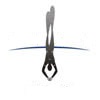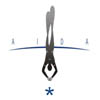|
home
|
APNOEVISION.CH
|
|
|
LAUFEND NEUE KURSE AIDA **Freediver Course Outline
PREREQUISITES To enrol in the AIDA ****Freediver course, an individual must:
•
Be 18 years of age or older (16 years with parent or guardian
consent) COURSE PURPOSE
The AIDA **** course is an advanced freediving course, designed to
continue a freediver’s training beyond the level of AIDA
***Freediver. It aims to meet the needs of those freedivers who want
to continue freediving beyond a recreational level. Students will be
familiarised with the techniques, knowledge and safety procedures
for deep freediving, such as exhale diving and mouth fill
equalising. They will develop their skills within the main
categories of freediving; Static Apnea, Dynamic Apnea, Constant
Weight, Free Immersion and Variable Weight, even though the main
focus is on Constant Weight. Besides the in water skills, the
students will be introduced to full body stretching, lung stretching
including packing and reverse packing, cross training and diet that
will benefit their freediving development. To conduct an AIDA ***Freediver course, the following knowledge development, stretching sessions, confined water dives and open water dives are to be included: KNOWLEDGE DEVELOPMENT
The knowledge development will take place in a classroom-like
environment. The knowledge development should be conducted using the AIDA ****Freediver Powerpoint slides. Students should be provided with a hand-out of the slides to take away for future reference and to use to prepare for their exam. They should also be provided with copies of the body and lung stretching documents. AIDA Instructors may supplement these slides with any updated information such as recent developments in freedive knowledge and information specific to freediving in the local area. You may find it useful to have other reference books handy such as an anatomy atlas, freedive DVDs, magazine articles or reference books.
The AIDA ****Freediver exam must be completed by any student
certified as an AIDA ****Freediver. The passing score is 75%. Any
missed questions should be explained to the student and the student
must sign the bottom of the exam to indicate that this has taken
place. If the student does not pass the exam on first sitting, they
may resit after 24 hours. The theory sessions will include:
•
Physics –Dalton’s Law, Boyle’s law, Henry’s law, Decompression
Sickness, • Failure depth- what does it mean, how to increase VC and decrease RV • Exhale diving- FRC, how and when to use it, dangers of exhale diving • Mouth fill- how and when to use it and benefits • Packing- how and when to use it and risks • Fitness for freediving- aerobic and anaerobic training, stretching, diet • Apnea Training- how to do breath hold training on land • Retrieval safety systems for freediving
•
(If combined with the AIDA Competition Freediver course) The AIDA
rules and
STRETCHING SESSION The intent of this part of the course is to make sure that the student freediver knows how to do a full body stretch and lung stretching so that they can use these skills as preparation before a dive session or regularly to increase general flexibility and specifically chest flexibility. These sessions should be conducted in a suitable environment. By the end of this session the student freediver will be able to:
•
Plan and perform a full body stretching suitable as preparation
before
The intent of this part of the course is to introduce the student to
packing during Static Apnea and to planning and performing a Dynamic
Apnea training session. It also includes refresher of the student
diver’s existing rescue skills. The sessions should be conducted in
a swimming pool or similar confined water (a pool of at least 20m in
length is recommended). The student freediver should have access to
either a floatation device or the side of the pool to support them
at the end of the breath hold. Confined Water Session One After this session the student freediver will be able to:
•
Perform a lung stretch as preparation
•
Perform a static breath-hold with packing of at least 3 minutes 30
seconds • Perform a dynamic swim of at least 70m
•
Act as a safety diver for a buddy performing a maximum dynamic Confined Water Session Two After this session the student freediver will be able to:
•
Perform a dynamic training session that the student has constructed.
•
Set the right buoyancy considering the different factors that will
affect the
•
Demonstrate the appropriate rescue technique for a freediver
experiencing
These dives should be conducted in open water with a fixed line to
be used as a point of reference by the student freediver. This line
should be sufficiently buoyed and weighted so that the student
freediver could use it to pull either up or down if necessary. The
line is recommended to be at least 8mm in diameter.
The Open Water training component of this course includes 4
sessions. These should take place over at least two days. The
student divers should be given the opportunity to leave the water to
warm up, rehydrate and take a break between each session. All skills
below have to be included in the course but the order can alter. Open Water Dive Session One After this open water session, the student freediver will be able to: • Perform a warm-up stretch of about 20 minutes
•
Prepare the set-up necessary for an OW dive session: student must be
confident • Understand the mechanism of exhale dives and practice them
•
Understand the mechanism of the Mouth fill technique and practice it
together • Remove one fin at the depth of 20m and swim back with only one fin
Open Water Dive Session Two After this open water session, the student freediver will be able to: • Perform a lung stretch as preparation for the dive session • Prepare the set-up necessary for an OW dive session • Use the Mouth fill technique in combination with exhale dives
•
Perform a VW dive in a safe manner, for depth and equalisation
training • Rescue a blacked out freediver from 20m • Ascend from 20m with no mask
Open Water Dive Session Three After this open water session, the student freediver will be able to: • Perform a full body stretch or a lung stretch as preparation for the dive session • Prepare the set-up necessary for an OW dive session
•
Perform a VW dive in a safe manner, for depth and equalisation
training
•
Perform a dive using the packing technique in combination with a
Mouth
Open Water Dive Session Four After this open water session, the student freediver will be able to: • Perform a full body stretch or a lung stretch as preparation for the dive session • Prepare the set-up necessary for an OW dive session
•
Plan an OW dive session with exhale dives as part of the warm-up,
followed
•
Perform a Constant Weight dive to a depth of at least 32m • Rescue a BO freediver from 15m using only one bi fin as propulsion
•
Tow an inert freediver to shore/boat. minimum 50m EQUIPMENT Student Equipment – mask, fins or monofin, snorkel, appropriate exposure protection, weightbelt, lanyard
Instructor Equipment –
mask, bi-fins, snorkel, appropriate exposure protection, weightbelt,
stop watch, depth gauge, lanyard, guideline with bottom plate,
floatation device, first aid kit, oxygen administration kit (in
countries where this is required or permitted by local law) VW
set-up, (If there is a student that is using Optional Equipment –nose clip, goggles, tags, lights, underwater video camera
The AIDA ****Freediver course may be conducted by an Active AIDA
Instructor with current CPR and First Aid training (completed within
the last two years).
The maximum student diver-to-instructor ratio for open water
training dives is four students per instructor (4:1). This may rise
to six students per instructor (6:1) when the instructor is assisted
by another freediver qualified to at least AIDA **** level. The
maximum student diver-to-instructor ratio in confined water is eight
students per instructor (8:1). With an AIDA ****Freediver acting as
an Assistant, 4 additional students may be added to this ratio to a
maximum of 12 students.
ADMINISTRATION AND PAPERWORK Before commencing any in-water training, each student freediver must complete the following documents, for students aged under 18 years, both must be co-signed by a parent or guardian:
•
AIDA Medical Statement – this must be completed in full with
students marking The AIDA Instructor should hold these documents on file for a minimum of seven years or longer if required by local legislation.
CERTIFICATION PROCEDURES Freedivers who meet all the performance requirements outlined above may be certified as an AIDA****Freediver.
Freedivers who complete the full AIDA ****Freediver course in
combination with the AIDA Competition Freediver course may be
certified as AIDA ****Competition Freediver (this is only possible
if the Instructor is an AIDA Judge). The certification request
should mot be send later than 3 month from the certification date. KEY STANDARDS
Prerequisite certifications: AIDA ***Freediver and current First Aid
AIDA Freediver Kurse
AIDA Spezial Kurse
|
||



 AIDA *Freediver
AIDA *Freediver AIDA **Freediver
AIDA **Freediver AIDA ***Freediver
AIDA ***Freediver


 AIDA Competiton
Freediver
AIDA Competiton
Freediver

.jpg) Entspannungs-/
Mentaltraining
Entspannungs-/
Mentaltraining